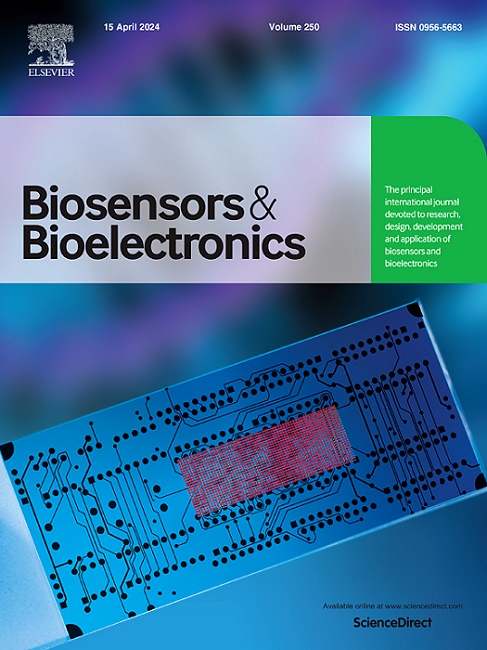Synergistic self-calibration strategy based on nano-cornucopia MOFs for accurate HER-2 detection in precision breast cancer diagnosis
IF 10.5
1区 生物学
Q1 BIOPHYSICS
引用次数: 0
Abstract
With its high porosity and tunable properties, metal-organic frameworks (MOFs) serve as nano-cornucopias, unlocking limitless possibilities in biosensing applications. Herein, we designed an ultrasensitive biosensor leveraging MOFs as a multifunctional nano-platform to implement a synergistic self-calibration strategy for the ultra-accurate quantification of breast cancer-related human epidermal growth factor receptor-2 (HER-2). This approach integrates (1) ratiometric electrochemistry for built-in correction to minimize non-specific interference and (2) dual-modal electrochemical and colorimetric detection for enhanced accuracy through cross-validation. Functionalized NH2-UiO-66 (Zr-MOF) was employed as a carrier to incorporate a dual-layer of anthraquinone-2-carboxylic acid (AQ), creating NH2-UiO-66@AQ, a highly electroactive nanomaterial for signal amplification. The incorporation of gold nanoparticles (AuNPs) and ionically reduced graphene oxide (IL-rGO) further enhanced conductivity and electrochemical response. Additionally, MOF@FeTCPP nanozyme was synthesized by encapsulating iron (III) meso-tetra(4-carboxyphenyl) porphyrin chloride (FeTCPP) into HKUST-1 (Cu-MOF), demonstrating exceptional peroxidase-like activity. Coupling this nanozyme with streptavidin (SA) resulted in the formation of a dual-signal nanozyme probe (DSN-Probe) capable of generating both electrochemical and colorimetric signals. The biosensor exhibited a broad detection range (100 fg/mL to 150 ng/mL) with an ultra-low limit of detection (LOD) of 28.509 fg/mL, effectively differentiating HER-2 expression in various cell lines and distinguishing HER-2 levels in serum samples from healthy individuals and breast cancer patients. Its adaptability to electrochemical workstations, microplate readers, and smartphones makes it ideal for point-of-care testing (POCT), reinforcing its potential as a powerful tool for drug mechanism studies and breast cancer diagnosis.

基于纳米聚角mof的HER-2精准检测协同自校准策略在乳腺癌精准诊断中的应用
金属有机骨架(mof)具有高孔隙率和可调特性,是纳米聚焦点,为生物传感应用提供了无限的可能性。在此,我们设计了一种超灵敏的生物传感器,利用mof作为多功能纳米平台,实现协同自校准策略,用于乳腺癌相关人表皮生长因子受体-2 (HER-2)的超精确定量。该方法集成了(1)比例电化学内置校正,以减少非特异性干扰;(2)双峰电化学和比色检测,通过交叉验证提高准确性。以功能化nh2 - uuo -66 (Zr-MOF)为载体,掺入双层蒽醌-2-羧酸(AQ),制备了具有高电活性的信号放大纳米材料NH2-UiO-66@AQ。金纳米颗粒(AuNPs)和离子还原氧化石墨烯(IL-rGO)的掺入进一步增强了电导率和电化学响应。此外,通过将铁(III)中四(4-羧基苯基)卟啉氯(FeTCPP)包封到HKUST-1 (Cu-MOF)中合成MOF@FeTCPP纳米酶,显示出优异的过氧化物酶样活性。将这种纳米酶与链亲和素(SA)偶联,形成了一种双信号纳米酶探针(DSN-Probe),能够产生电化学和比色信号。该传感器具有较宽的检测范围(100 fg/mL ~ 150 ng/mL),超低检测限(LOD)为28.509 fg/mL,可有效区分HER-2在各种细胞系中的表达,并可区分健康人及乳腺癌患者血清样品中的HER-2水平。它对电化学工作站,微孔板读取器和智能手机的适应性使其成为护理点检测(POCT)的理想选择,增强了其作为药物机制研究和乳腺癌诊断的强大工具的潜力。
本文章由计算机程序翻译,如有差异,请以英文原文为准。
求助全文
约1分钟内获得全文
求助全文
来源期刊

Biosensors and Bioelectronics
工程技术-电化学
CiteScore
20.80
自引率
7.10%
发文量
1006
审稿时长
29 days
期刊介绍:
Biosensors & Bioelectronics, along with its open access companion journal Biosensors & Bioelectronics: X, is the leading international publication in the field of biosensors and bioelectronics. It covers research, design, development, and application of biosensors, which are analytical devices incorporating biological materials with physicochemical transducers. These devices, including sensors, DNA chips, electronic noses, and lab-on-a-chip, produce digital signals proportional to specific analytes. Examples include immunosensors and enzyme-based biosensors, applied in various fields such as medicine, environmental monitoring, and food industry. The journal also focuses on molecular and supramolecular structures for enhancing device performance.
 求助内容:
求助内容: 应助结果提醒方式:
应助结果提醒方式:


